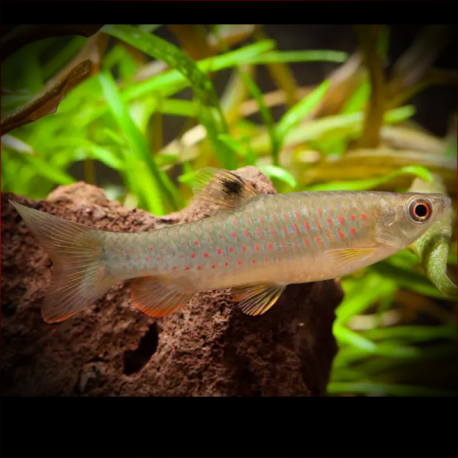More info
Datasheet
| Minimum Tank Size | 120 litres / 31.70 US gallons |
| Maximum Size | 7.6cm / 2.99inches |
| Temperature | 20°C / 68.00°F - 28°C / 82.40°F |
| Hardness | 1.01dgH / 18ppm - 10.03dgH / 179ppm |
| pH | 4.0-7.5 |
General Description
The family Lebiasinidae is part of the order Characiformes and may be divided into the nominal subfamilies Lebiasininae and Pyrrhulininae. These fishes typically have a slender body with 17-33 scales in the lateral series and lack a well-developed laterosensory canal system. Some species have an adipose fin, while others do not, and their anal fins have a relatively short base of 13 scales or less. Male members often feature an enlarged anal fin used for courtship and spawning. These fish lack a frontal/parietal fontanelle, have the cheek well-covered by orbital and opercular bones, and the scales of the dorsal body start over the parietal bones. The order Characiformes is known for its diversity, with approximately 2000 valid species across 19 families.
Aquarium Setup
The Red-Spotted Tetra thrives in a well-furnished aquarium with live plants and a dark substrate. To enhance its coloration, provide a soft, sandy substrate with wood roots and branches creating shady spots. Dim lighting is preferable, and plant species like Microsorum, Taxiphyllum, Cryptocoryne, or Anubias are recommended as they can grow in such conditions. Regular water changes are essential to maintain water quality, as these fish are intolerant to organic pollutants and should not be introduced to a biologically immature tank. Refer to the recommended water conditions in the table for optimal care.
Behaviour
The Red-Spotted Tetra engages in interesting reproductive behaviors where males guard the eggs deposited in shallow depressions excavated from the substrate. Males exhibit more vibrant coloration than females and may develop extended fins, showcasing sexual dimorphism.
Feeding and Diet
In their natural habitat, Red-Spotted Tetras likely feed on insects near the water surface. In aquariums, they readily accept small live and frozen foods such as bloodworms, Daphnia, and Artemia. A diet supplemented with quality dried flakes and granules containing plant or algal content is ideal for their nutritional needs.
Reproduction & Dimorphism
These tetras exhibit a unique reproductive strategy where males guard the eggs. Sexual dimorphism is evident, with males displaying brighter colors and extended fins compared to females.
Habitat and Distribution
The Red-Spotted Tetra is found in the middle and upper Amazon river basins in countries including Brazil, Peru, Ecuador, and Colombia. The species' type locality is recorded as the Amazon River at Obidos, Cudajas, and Tabatinga, as well as the Rio Negro in Brazil.
Note: Refer to the table for specific tank size and water parameter requirements.

